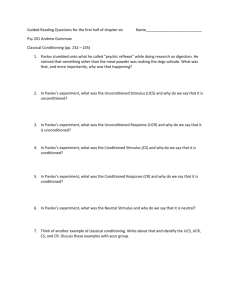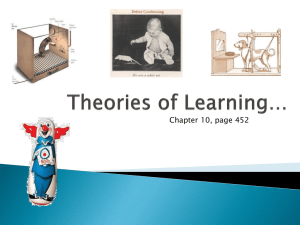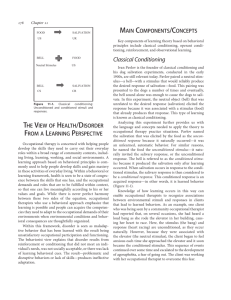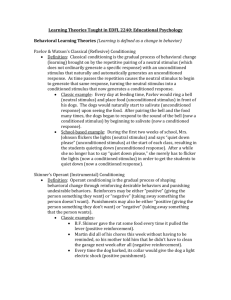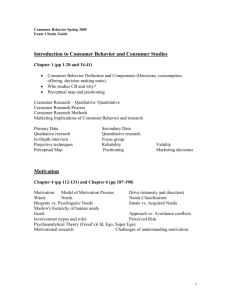CLASSICAL CONDITIONING
advertisement
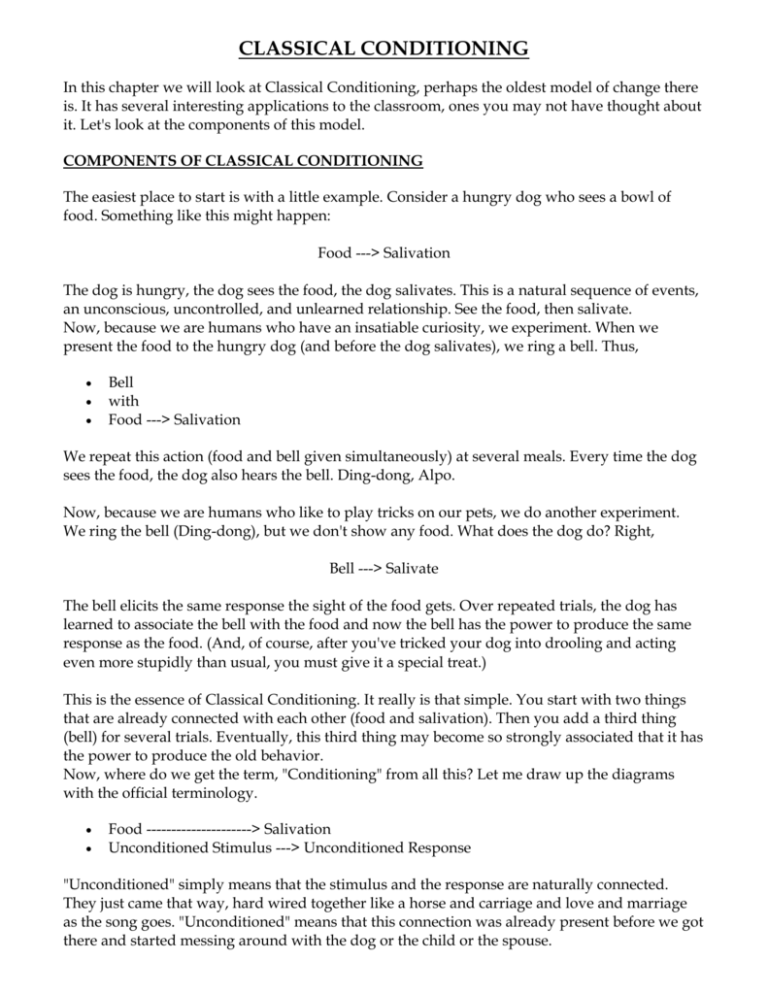
CLASSICAL CONDITIONING In this chapter we will look at Classical Conditioning, perhaps the oldest model of change there is. It has several interesting applications to the classroom, ones you may not have thought about it. Let's look at the components of this model. COMPONENTS OF CLASSICAL CONDITIONING The easiest place to start is with a little example. Consider a hungry dog who sees a bowl of food. Something like this might happen: Food ---> Salivation The dog is hungry, the dog sees the food, the dog salivates. This is a natural sequence of events, an unconscious, uncontrolled, and unlearned relationship. See the food, then salivate. Now, because we are humans who have an insatiable curiosity, we experiment. When we present the food to the hungry dog (and before the dog salivates), we ring a bell. Thus, Bell with Food ---> Salivation We repeat this action (food and bell given simultaneously) at several meals. Every time the dog sees the food, the dog also hears the bell. Ding-dong, Alpo. Now, because we are humans who like to play tricks on our pets, we do another experiment. We ring the bell (Ding-dong), but we don't show any food. What does the dog do? Right, Bell ---> Salivate The bell elicits the same response the sight of the food gets. Over repeated trials, the dog has learned to associate the bell with the food and now the bell has the power to produce the same response as the food. (And, of course, after you've tricked your dog into drooling and acting even more stupidly than usual, you must give it a special treat.) This is the essence of Classical Conditioning. It really is that simple. You start with two things that are already connected with each other (food and salivation). Then you add a third thing (bell) for several trials. Eventually, this third thing may become so strongly associated that it has the power to produce the old behavior. Now, where do we get the term, "Conditioning" from all this? Let me draw up the diagrams with the official terminology. Food ---------------------> Salivation Unconditioned Stimulus ---> Unconditioned Response "Unconditioned" simply means that the stimulus and the response are naturally connected. They just came that way, hard wired together like a horse and carriage and love and marriage as the song goes. "Unconditioned" means that this connection was already present before we got there and started messing around with the dog or the child or the spouse. "Stimulus" simply means the thing that starts it while "response" means the thing that ends it. A stimulus elicits and a response is elicited. (This is circular reasoning, true, but hang in there.) Another diagram, Conditioning Stimulus Bell with Food -----------------------> Salivation Unconditioned Stimulus------> Unconditioned Response We already know that "Unconditioned" means unlearned, untaught, preexisting, alreadypresent-before-we-got-there. "Conditioning" just means the opposite. It means that we are trying to associate, connect, bond, link something new with the old relationship. And we want this new thing to elicit (rather than be elicited) so it will be a stimulus and not a response. Finally, after many trials we hope for, Bell ---------------------> Salivation Conditioned Stimulus ---> Conditioned Response Let's review these concepts. 1. 2. 3. 4. Unconditioned Stimulus: a thing that can already elicit a response. Unconditioned Response: a thing that is already elicited by a stimulus. Unconditioned Relationship: an existing stimulus-response connection. Conditioning Stimulus: a new stimulus we deliver the same time we give the old stimulus. 5. Conditioned Relationship: the new stimulus-response relationship we created by associating a new stimulus with an old response. There are two key parts. First, we start with an existing relationship, Unconditioned Stimulus --> Unconditioned Response. Second, we pair a new thing (Conditioning Stimulus) with the existing relationship, until the new thing has the power to elicit the old response. EVERYDAY CLASSICAL CONDITIONING This type of influence is extremely common. If you have pets and you feed them with canned food, what happens when you hit the can opener? Sure, the animals come running even if you are opening a can of green beans. They have associated the sound of the opener with their food. Classical conditioning works with people, too. Go to K-Mart and watch what happens when the blue light turns on. Cost conscious shoppers will make a beeline to that table because they associate a good sale with the blue light. (And, the research proves that people are more likely to buy the sale item under the blue light even if the item isn't a good value.) To discourage coyotes from attacking their sheep, ranchers fed the coyotes small pieces of mutton (sheep meat) tainted with poison that, when eaten, caused the coyotes to experience extreme dizziness & nausea. Later, when the coyotes are near the pen with the sheep, the mere smell of sheep causes the coyotes to run frantically away from their former prey. Remember to look for the unconditioned response first, & use this to discover the unconditioned stimulus (the cause of the response). 1. A dog salivates whenever food is put in front of it. To make things interesting, the owner of the dog begins to ring a bell every time food is given to the dog. Eventually, all the owner has to do is ring the bell & the dog begins to drool. a) unconditioned stimulus (UCS)-b) unconditioned response (UCR)-d) conditioned stimulus (CS)-e) conditioned response (CR)— 2. The nurse says “Now, this won’t hurt a bit” just before stabbing you in the arm with a needle. The next time you hear the words “this won’t hurt” you cringe. a) unconditioned stimulus (UCS)-b) unconditioned response (UCR)-d) conditioned stimulus (CS)-e) conditioned response (CR)— 3. Joe just returned from a military tour in Afghanistan. Every night (in Afghanistan), rockets were fired at this platoon & he would have to dive for cover. Now, back in the U.S., whenever he hears a loud noise he ducks his head anxiously. a) unconditioned stimulus (UCS)-b) unconditioned response (UCR)-d) conditioned stimulus (CS)-e) conditioned response (CR)—

